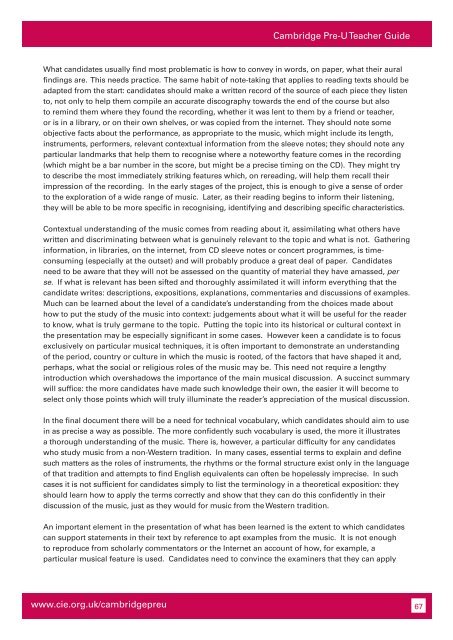Teacher's Guide Cambridge Pre-U MUSIC Available for teaching ...
Teacher's Guide Cambridge Pre-U MUSIC Available for teaching ...
Teacher's Guide Cambridge Pre-U MUSIC Available for teaching ...
You also want an ePaper? Increase the reach of your titles
YUMPU automatically turns print PDFs into web optimized ePapers that Google loves.
<strong>Cambridge</strong> <strong>Pre</strong>-U Teacher <strong>Guide</strong><br />
What candidates usually find most problematic is how to convey in words, on paper, what their aural<br />
findings are. This needs practice. The same habit of note-taking that applies to reading texts should be<br />
adapted from the start: candidates should make a written record of the source of each piece they listen<br />
to, not only to help them compile an accurate discography towards the end of the course but also<br />
to remind them where they found the recording, whether it was lent to them by a friend or teacher,<br />
or is in a library, or on their own shelves, or was copied from the internet. They should note some<br />
objective facts about the per<strong>for</strong>mance, as appropriate to the music, which might include its length,<br />
instruments, per<strong>for</strong>mers, relevant contextual in<strong>for</strong>mation from the sleeve notes; they should note any<br />
particular landmarks that help them to recognise where a noteworthy feature comes in the recording<br />
(which might be a bar number in the score, but might be a precise timing on the CD). They might try<br />
to describe the most immediately striking features which, on rereading, will help them recall their<br />
impression of the recording. In the early stages of the project, this is enough to give a sense of order<br />
to the exploration of a wide range of music. Later, as their reading begins to in<strong>for</strong>m their listening,<br />
they will be able to be more specific in recognising, identifying and describing specific characteristics.<br />
Contextual understanding of the music comes from reading about it, assimilating what others have<br />
written and discriminating between what is genuinely relevant to the topic and what is not. Gathering<br />
in<strong>for</strong>mation, in libraries, on the internet, from CD sleeve notes or concert programmes, is timeconsuming<br />
(especially at the outset) and will probably produce a great deal of paper. Candidates<br />
need to be aware that they will not be assessed on the quantity of material they have amassed, per<br />
se. If what is relevant has been sifted and thoroughly assimilated it will in<strong>for</strong>m everything that the<br />
candidate writes: descriptions, expositions, explanations, commentaries and discussions of examples.<br />
Much can be learned about the level of a candidate’s understanding from the choices made about<br />
how to put the study of the music into context: judgements about what it will be useful <strong>for</strong> the reader<br />
to know, what is truly germane to the topic. Putting the topic into its historical or cultural context in<br />
the presentation may be especially significant in some cases. However keen a candidate is to focus<br />
exclusively on particular musical techniques, it is often important to demonstrate an understanding<br />
of the period, country or culture in which the music is rooted, of the factors that have shaped it and,<br />
perhaps, what the social or religious roles of the music may be. This need not require a lengthy<br />
introduction which overshadows the importance of the main musical discussion. A succinct summary<br />
will suffice: the more candidates have made such knowledge their own, the easier it will become to<br />
select only those points which will truly illuminate the reader’s appreciation of the musical discussion.<br />
In the final document there will be a need <strong>for</strong> technical vocabulary, which candidates should aim to use<br />
in as precise a way as possible. The more confidently such vocabulary is used, the more it illustrates<br />
a thorough understanding of the music. There is, however, a particular difficulty <strong>for</strong> any candidates<br />
who study music from a non-Western tradition. In many cases, essential terms to explain and define<br />
such matters as the roles of instruments, the rhythms or the <strong>for</strong>mal structure exist only in the language<br />
of that tradition and attempts to find English equivalents can often be hopelessly imprecise. In such<br />
cases it is not sufficient <strong>for</strong> candidates simply to list the terminology in a theoretical exposition: they<br />
should learn how to apply the terms correctly and show that they can do this confidently in their<br />
discussion of the music, just as they would <strong>for</strong> music from the Western tradition.<br />
An important element in the presentation of what has been learned is the extent to which candidates<br />
can support statements in their text by reference to apt examples from the music. It is not enough<br />
to reproduce from scholarly commentators or the Internet an account of how, <strong>for</strong> example, a<br />
particular musical feature is used. Candidates need to convince the examiners that they can apply<br />
www.cie.org.uk/cambridgepreu 67
















